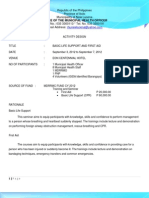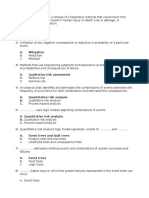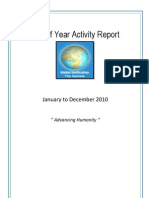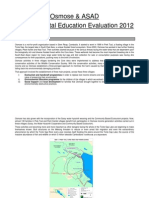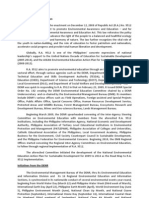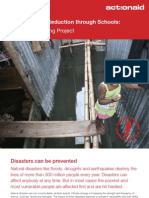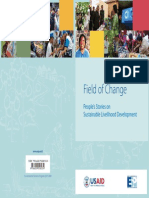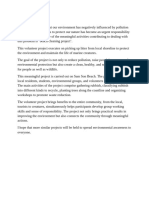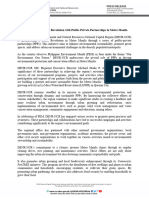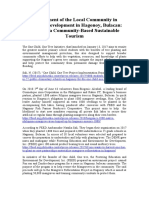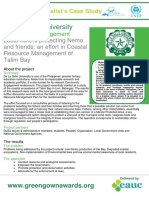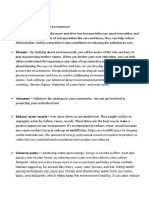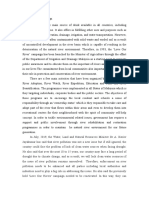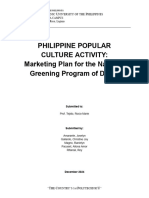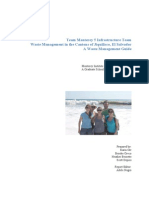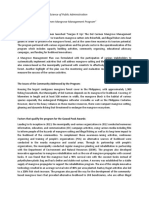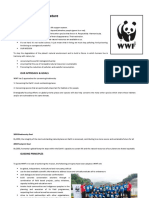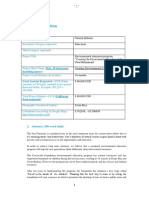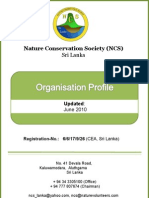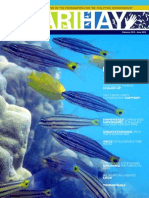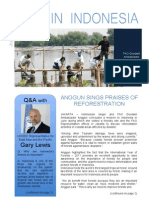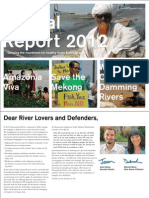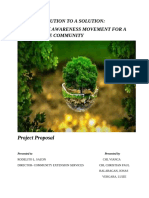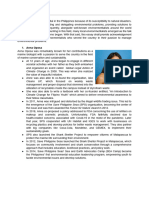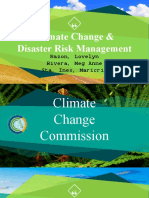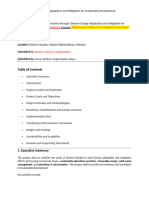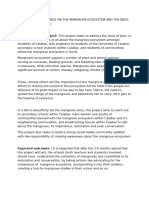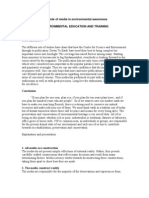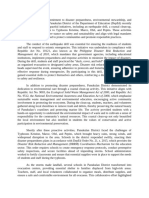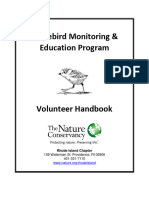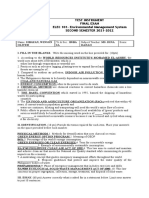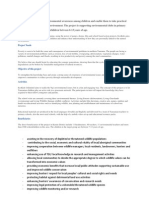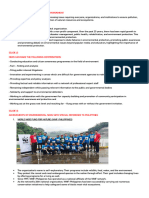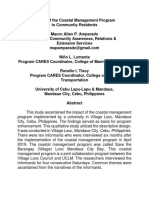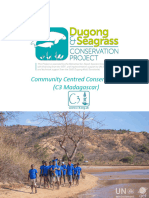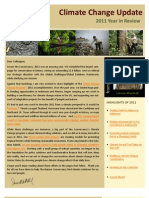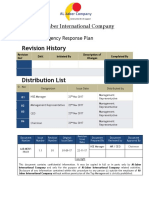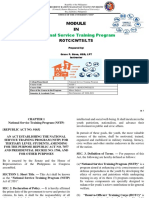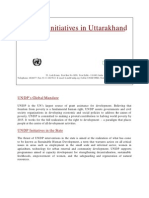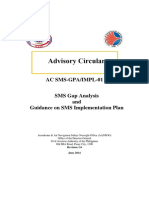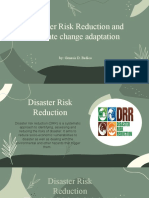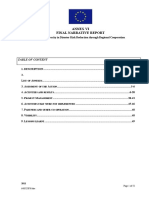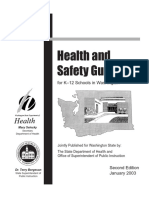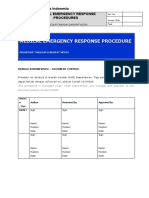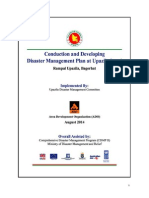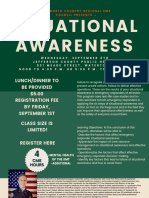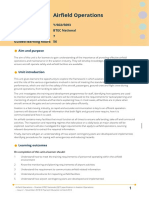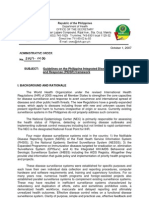Case Study Philippines - Disaster Preparedness
Case Study Philippines - Disaster Preparedness
Uploaded by
Cha SalardaCopyright:
Available Formats
Case Study Philippines - Disaster Preparedness
Case Study Philippines - Disaster Preparedness
Uploaded by
Cha SalardaCopyright
Available Formats
Share this document
Did you find this document useful?
Is this content inappropriate?
Copyright:
Available Formats
Case Study Philippines - Disaster Preparedness
Case Study Philippines - Disaster Preparedness
Uploaded by
Cha SalardaCopyright:
Available Formats
Case study: Philippine Red Cross and young people partner in community preparedness
May 8 is World Red Cross Red Crescent Day. Youth on the move is the theme for 2012 and we are calling upon young people to build on the existing Youth on the move initiative by taking action in one of three areas: 1) helping communities better prepare in the face of increasing disasters, 2) addressing health care in danger or inequitable access to health care, or 3) building a culture of non-violence and peace. Here is one example of Red Cross Red Crescent youth in action. Youth initiative replanting, adapting to climate change In an effort to raise environmental awareness among youth, the Philippine Red Cross (PRC) developed the Run, Plant and Care for the Mangroves and our Environment project to help young people better prepare in the face of adverse climate change effects in the Compostela Valley province. The mangrove project helping communities better prepare for disasters In response to the decline of mangrove forests, the planting of mangrove trees is encouraged as a rehabilitation activity to protect fishpond dykes and homes from sea surges and storm damage. In the Compostela Valley province, youth workshops by the PRC seek to rehabilitate and develop the local mangrove area as a fish sanctuary and tree park, as well as teach community members disaster preparedness and response skills. Youth involvement is critical as it ensures that the catalyst for change is lead by tomorrows local leaders. During the projects first month of implementation in January 2012, seven disaster risk reduction orientation sessions took place in high schools and elementary schools within the Pantukan district and reached almost 800 participants, including mostly intermediate students, parents, faculty members and school administrators. A series of Red Cross Youth Council and disaster risk reduction activities have been conducted in three coastal municipalities: Maco, Mabini and Pantukan, as well as the Laak and Nabunturan municipalities. During these sessions, 13 schools and over 5,000 people participated to learn about topics such as mangrove management and the Run, Plant and Care for the Mangroves project, disaster risk reduction, international humanitarian law, the Red Cross Red Crescent Movement, and Philippine Red Cross services and volunteerism.
YOUTH ON THE MOVE World Red Cross Red Crescent Day 8 May 2012
To help fundraise for the project and to highlight the 22 April 2012 Earth Day celebrations, a Run for Humanity has been organized for all Davao region and nationwide runners, Red Cross youth, supporters and volunteers.
Key achievements and the way forward In the first three months of the projects implementation (January to March 2012), key achievements include: Over 6,000 people participated in activities related to the mangrove project, supporting tree planting and learning disaster preparedness skills. More than 1,000 trees have been planted with plans to reach 15,000 trees by the end of the year. The tree planting will enable a major source of livelihood for the future. Fishpond dykes will be protected so fish production can increase in the longterm. And seeds from the planted mangroves can eventually serve as suppliers of seeds that can be sold, providing an additional source of income. The Run, Plant and Care for the Mangroves and our Environment project has also improved the way Philippine Red Cross youth, staff and volunteers view the effects of climate change in mangrove areas, making them feel more hopeful for the future.
Looking to the future, a mangrove tree park and nursery to help sustain rehabilitation activities will be established with local partners. It is expected to serve as a model in terms of disaster risk reduction and preparedness activities for other neighbouring villages and municipalities. By the end of the project, participating communities will also have at least one team of Red Cross volunteers trained in first-aid, CPR and disaster preparedness, so they can better respond to disasters and emergencies.
You might also like
- Activity DesignDocument2 pagesActivity DesignRhu New Lucena90% (21)
- WWF Philippines PrimerDocument5 pagesWWF Philippines PrimerMulat Pinoy-Kabataan News NetworkNo ratings yet
- API 580 Mcqs (119 Nos.)Document19 pagesAPI 580 Mcqs (119 Nos.)muhammadazhar100% (2)
- Guidance Notes-Safety in Offshore OperationsDocument183 pagesGuidance Notes-Safety in Offshore Operationszebxxyeq100% (1)
- End of Year Report 2010Document17 pagesEnd of Year Report 2010Ebrima S. DemNo ratings yet
- Participatory Media On The Tonle Sap Lake, CambodiaDocument14 pagesParticipatory Media On The Tonle Sap Lake, CambodiaMartin PotterNo ratings yet
- Phil Environmental Education (1) .Case StudyDocument12 pagesPhil Environmental Education (1) .Case StudyCatherine Galano PradoNo ratings yet
- Disaster Risk Reduction Through SchoolsDocument8 pagesDisaster Risk Reduction Through SchoolsTova GeografNo ratings yet
- Green World ProjectsDocument9 pagesGreen World ProjectsAaron JoseNo ratings yet
- Case Studies UNDP: COMMUNITY-BASED MARINE MANAGEMENT FOUNDATION, IndonesiaDocument14 pagesCase Studies UNDP: COMMUNITY-BASED MARINE MANAGEMENT FOUNDATION, IndonesiaUNDP_EnvironmentNo ratings yet
- EnvironmentalAwareness UNDocument4 pagesEnvironmentalAwareness UNJemmiean PeñaNo ratings yet
- Local Faith Community (LFC) Children and Youths As Catalysts For Disaster Resilience: Experience Sharing From Pathfinders in IndonesiaDocument5 pagesLocal Faith Community (LFC) Children and Youths As Catalysts For Disaster Resilience: Experience Sharing From Pathfinders in IndonesiakyriakoseNo ratings yet
- Case Studies UNDP: KALINGA MISSION FOR INDIGENOUS CHILDREN AND YOUTH DEVELOPMENT INC (KAMICYDI), PhilippinesDocument12 pagesCase Studies UNDP: KALINGA MISSION FOR INDIGENOUS CHILDREN AND YOUTH DEVELOPMENT INC (KAMICYDI), PhilippinesUNDP_Environment100% (2)
- Field of ChangeDocument75 pagesField of ChangeMulyo SantosoNo ratings yet
- Project Group 4Document1 pageProject Group 4builevan009No ratings yet
- Press Release DENR NCR Drives Green Revolution in Celeb of PEMDocument2 pagesPress Release DENR NCR Drives Green Revolution in Celeb of PEMtiratiramodaNo ratings yet
- Human & Environment Links Progressive OrganizationDocument14 pagesHuman & Environment Links Progressive OrganizationNadeesha GodakandaNo ratings yet
- Thesis RRL FinalDocument8 pagesThesis RRL Finalreynalyn santosNo ratings yet
- An Ordinance Institutionalizing The First Week of June Annually As The Oriental Mindoro Environment Week and Appropriating Funds ThereofDocument5 pagesAn Ordinance Institutionalizing The First Week of June Annually As The Oriental Mindoro Environment Week and Appropriating Funds ThereofLuis NovenarioNo ratings yet
- Activity Design (PD)Document7 pagesActivity Design (PD)Andrea AtonducanNo ratings yet
- Gupes Gga 2016 Case Study de La Salle University - Edited 1Document3 pagesGupes Gga 2016 Case Study de La Salle University - Edited 1api-310321509No ratings yet
- Medical Lab Report ScriptDocument5 pagesMedical Lab Report ScriptFreddy MarsucNo ratings yet
- Module 6 Enabling Assessment Mac Proposal DraftDocument5 pagesModule 6 Enabling Assessment Mac Proposal Draftyow BroNo ratings yet
- Love Our River CampaignDocument4 pagesLove Our River CampaignAM2283H SITI NURFARAHIN BINTI INDRANo ratings yet
- PPC Marketing PlanDocument11 pagesPPC Marketing PlanRanielyn MagnoNo ratings yet
- Coral Triangle PhiDocument105 pagesCoral Triangle PhiDenny Boy MochranNo ratings yet
- Quantitree Project ProposalDocument13 pagesQuantitree Project Proposals2023108281No ratings yet
- Team Monterey 5 Infrastructure Team Waste Management in The Cantons of Jiquilisco, El Salvador A Waste Management GuideDocument22 pagesTeam Monterey 5 Infrastructure Team Waste Management in The Cantons of Jiquilisco, El Salvador A Waste Management GuideTeam El SalvadorNo ratings yet
- MPA 621 - Philosophy and Science of Public Administration Gawad Pook Award 2018 "Siargao It Up! The Del Carmen Mangrove Management Program"Document3 pagesMPA 621 - Philosophy and Science of Public Administration Gawad Pook Award 2018 "Siargao It Up! The Del Carmen Mangrove Management Program"antolin becerilNo ratings yet
- World Wide Fund For Nature: Our AimDocument12 pagesWorld Wide Fund For Nature: Our AimarnelNo ratings yet
- Project Metamorphosis: "Operation Clean-Up Drive Towards Community Progress" A Project by Team Loyalty I. Project TitleDocument10 pagesProject Metamorphosis: "Operation Clean-Up Drive Towards Community Progress" A Project by Team Loyalty I. Project TitleChristian Villa100% (2)
- Project Information: 1. SummaryDocument15 pagesProject Information: 1. SummaryMaria Victoria PadroNo ratings yet
- Project Proposal Tree Planting and Environmental Campaign Project TpecpDocument5 pagesProject Proposal Tree Planting and Environmental Campaign Project TpecpHassaniNo ratings yet
- NCS Profile June10Document12 pagesNCS Profile June10ncs_lankaNo ratings yet
- Sarihay 3rd IssueDocument16 pagesSarihay 3rd Issuefpe_scribdNo ratings yet
- Anggun Sings Praises of Reforestration: UNODC Representative For East Asia and The PacificDocument11 pagesAnggun Sings Praises of Reforestration: UNODC Representative For East Asia and The PacificAdilaNo ratings yet
- The Four C's Cycle ModelDocument48 pagesThe Four C's Cycle Modelfpe_scribdNo ratings yet
- International Rivers 2012 Annual ReportDocument16 pagesInternational Rivers 2012 Annual ReportInternational RiversNo ratings yet
- uge2-proposalDocument12 pagesuge2-proposalChristine DaclesNo ratings yet
- Escie ReyesDocument5 pagesEscie Reyesandrheaclarisse.reyes.cvtNo ratings yet
- SWM Module For SchoolsDocument142 pagesSWM Module For Schoolsjoanna gurtizaNo ratings yet
- Conservation, Restoration and Sustainable Utilization of Mangrove Ecosystem in Gonzaga CagayanDocument5 pagesConservation, Restoration and Sustainable Utilization of Mangrove Ecosystem in Gonzaga CagayanSibal P. IdnoNo ratings yet
- R.A. 9512 or The National Environment Awareness and Education ActDocument10 pagesR.A. 9512 or The National Environment Awareness and Education ActMelody SaipenNo ratings yet
- Report, Green EdDocument7 pagesReport, Green EdMelvin VillaruzNo ratings yet
- Niger Delta Mangrove Citizen Science ProjectDocument12 pagesNiger Delta Mangrove Citizen Science ProjectAdeniran KehindeNo ratings yet
- Climate Change & Disaster Risk Management: Razon, Lovelyn Rivera, Meg Anne Sta. Ines, MaricrisDocument56 pagesClimate Change & Disaster Risk Management: Razon, Lovelyn Rivera, Meg Anne Sta. Ines, MaricrisMeg Anne Legaspi RiveraNo ratings yet
- Youth-Led Climate Change Adaptation and Mitigation For Sustainable DevelopmentDocument9 pagesYouth-Led Climate Change Adaptation and Mitigation For Sustainable Developmentpirashraf786No ratings yet
- 14-15 Module 4Document15 pages14-15 Module 4Abigail Faye RoxasNo ratings yet
- Yegwa Courage - TRA Project.Document2 pagesYegwa Courage - TRA Project.Jude EduNo ratings yet
- Role of Media in Environmental AwerenessDocument14 pagesRole of Media in Environmental AwerenessDivya JainNo ratings yet
- District Earthquake drill NarrativeDocument2 pagesDistrict Earthquake drill NarrativeJohn Rex VillanuevaNo ratings yet
- Goosewing Volunteer HandbookDocument38 pagesGoosewing Volunteer HandbookisaNo ratings yet
- Sample Proposal On Biodiversity Conservation To Promote Sustainable LivelihoodsDocument6 pagesSample Proposal On Biodiversity Conservation To Promote Sustainable LivelihoodsDenis Felix DrotiNo ratings yet
- SST ProjectDocument11 pagesSST Projectdemo24816No ratings yet
- Sibayan, Winson Oliver - Bsba2a - Final Exam EnvimanDocument3 pagesSibayan, Winson Oliver - Bsba2a - Final Exam EnvimanSIBAYAN, WINSON OLIVERNo ratings yet
- Eco KidsDocument11 pagesEco KidsJosphine Mundava MaringaNo ratings yet
- Role of NGOsDocument2 pagesRole of NGOsBabyjoyNo ratings yet
- SEED - WORLD OCEANS DAY - THE SCIENCE WE NEED FOR THE OCEAN WE WANT (Social Enterprise For Environmental Development)Document2 pagesSEED - WORLD OCEANS DAY - THE SCIENCE WE NEED FOR THE OCEAN WE WANT (Social Enterprise For Environmental Development)Alphonsius WongNo ratings yet
- Environmental ScienceDocument3 pagesEnvironmental ScienceJerrobless DakiwasNo ratings yet
- Impact of The Coastal Management ProgramDocument13 pagesImpact of The Coastal Management ProgramMaria Jona BarrazaNo ratings yet
- Day2 7.comms C3Document31 pagesDay2 7.comms C3nikitanitika4No ratings yet
- 2011 Climate Change Year in ReviewDocument5 pages2011 Climate Change Year in ReviewAsti WasistiniNo ratings yet
- Medical Emergency Response PlanDocument12 pagesMedical Emergency Response PlanImtiyaz Akhtar100% (1)
- FGSR Example Gas Emergency Escape PlanDocument36 pagesFGSR Example Gas Emergency Escape PlanAnonymous GfPSYi4nNo ratings yet
- CBC Elect Install & Maint NC IIDocument64 pagesCBC Elect Install & Maint NC IIArvin Pahit79% (14)
- National Service Training Program: Rotc/Cwts/LtsDocument49 pagesNational Service Training Program: Rotc/Cwts/Ltsgwy FalloranNo ratings yet
- UNDP Initiatives in UttarakhandDocument6 pagesUNDP Initiatives in Uttarakhandprayaga.orgNo ratings yet
- A Survey On Level of Awareness and DisasDocument35 pagesA Survey On Level of Awareness and DisasJeff Andrian ParienteNo ratings yet
- Ac Sms-Gpa Impl-01Document18 pagesAc Sms-Gpa Impl-01Dharmendra Sumitra UpadhyayNo ratings yet
- Disaster Risk Reduction and Climate Change adaptation-PPT-GENESIS D. BEDICODocument12 pagesDisaster Risk Reduction and Climate Change adaptation-PPT-GENESIS D. BEDICOHanna Maria Santiano100% (1)
- Sample Narrative ReportDocument52 pagesSample Narrative ReportNormelyn IbadNo ratings yet
- DRRR Q1 Week 2 L4 5Document11 pagesDRRR Q1 Week 2 L4 5Mauler YabutNo ratings yet
- SOP Police by SSP CiDocument40 pagesSOP Police by SSP CiNanda Win LwinNo ratings yet
- Health and Safety Guide: For K-12 Schools in WashingtonDocument91 pagesHealth and Safety Guide: For K-12 Schools in Washingtonmartin kevinNo ratings yet
- Triage NotesDocument5 pagesTriage NotesWyen Cabatbat67% (3)
- HAZOp Report - BFI PDFDocument62 pagesHAZOp Report - BFI PDFJoseph Samir EshakNo ratings yet
- Awareness TyphoonsDocument5 pagesAwareness TyphoonsWiljohn de la CruzNo ratings yet
- MEDICAL EMERGENCY RESPONSE PLAN (Bilingual Template)Document42 pagesMEDICAL EMERGENCY RESPONSE PLAN (Bilingual Template)farid akbarNo ratings yet
- DM Plan Rampal Upazila Bagerhat District - English Version-2014Document183 pagesDM Plan Rampal Upazila Bagerhat District - English Version-2014CDMP Bangladesh100% (2)
- Case Study 02 Mohammed Elsayed Helmi DarwishDocument3 pagesCase Study 02 Mohammed Elsayed Helmi DarwishMOhamed helmiNo ratings yet
- Situational Awareness TrainingDocument1 pageSituational Awareness TrainingFDRHPO North Country EMS Program AgencyNo ratings yet
- Primer On Campus Earthquake Drill 2014Document5 pagesPrimer On Campus Earthquake Drill 2014Gom-o Eugenio JrNo ratings yet
- She21 (H)Document31 pagesShe21 (H)TerryNo ratings yet
- Wbscte - Gpa SystemDocument39 pagesWbscte - Gpa SystemnurNo ratings yet
- Implementing The LRRD Approach in Post Earthquake Rehabilitation in GujaratDocument20 pagesImplementing The LRRD Approach in Post Earthquake Rehabilitation in GujaratNeeraj LabhNo ratings yet
- Unit 27: Airfi Eld Operations: Unit Code: Y/602/5693 QCF Level 3: BTEC National Credit Value: 7 Guided Learning Hours: 56Document16 pagesUnit 27: Airfi Eld Operations: Unit Code: Y/602/5693 QCF Level 3: BTEC National Credit Value: 7 Guided Learning Hours: 56JamesNo ratings yet
- Emergency Medical ServiceDocument30 pagesEmergency Medical ServiceKeLvin AngeLes100% (1)
- A Disaster Is A Serious Disruption of The Functioning of A Community or A Society Involving Widespread HumanDocument6 pagesA Disaster Is A Serious Disruption of The Functioning of A Community or A Society Involving Widespread HumanJeeya PandeyNo ratings yet
- Ao 2007-0036 Pidsr PDFDocument16 pagesAo 2007-0036 Pidsr PDFRey San Luis III100% (2)
